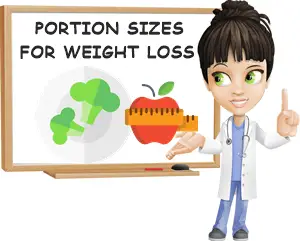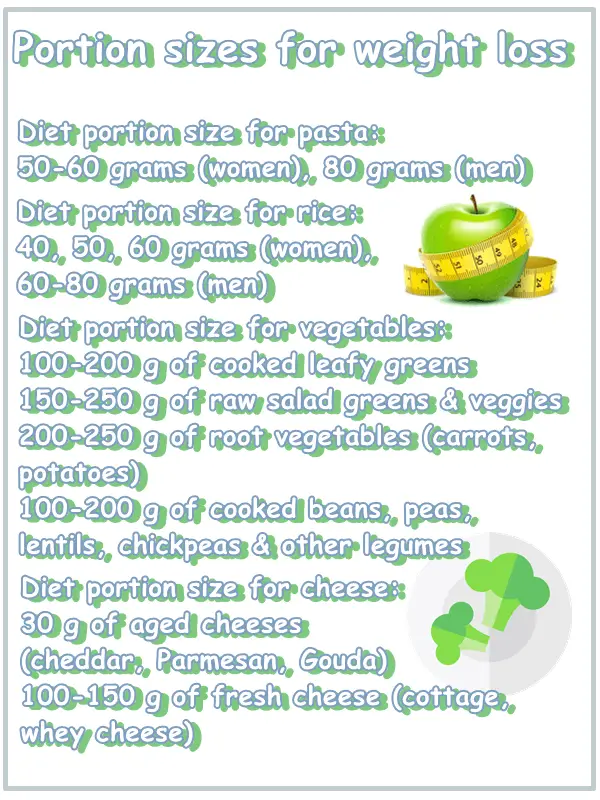Portion control is the ultimate secret to losing weight and keeping it off. If you are embarking on a weight loss diet, then one of the biggest guiding principles to follow is to practice portion control.
Whether yours is a plain hypocaloric or low calorie diet, a low carb diet, a high protein diet such as the keto or the Atkins diet, or more of a change in lifestyle in the form of a vegetarian, vegan or carnivore diet, eating smaller portions is what will help you achieve your end goal.
But how much of a food should you eat when you’re on a diet? What is a good diet portion of pasta? What is a good diet portion of rice? What is a good diet portion of bread? What about other foods that are more diet friendly, such as fruits and vegetables? How much of these should you eat for weight loss?

What is a diet portion size for weight loss?
Diet portion size in the context of a weight loss diet represents a specific amount of a food that you can eat while on a weight loss diet to help you lose weight. Diet portion sizes are smaller food portions that are meant to supply fewer calories so that you can achieve a calorie deficit that is conducive to weight loss. In simpler words, dieting requires you to eat smaller portion sizes than you normally would to be able to lose weight.
Portion sizes for weight loss
What constitutes a diet portion size for weight loss? There is no universal diet portion size that can be applied to absolutely everyone looking to lose weight. Some people will need to eat more, and some people will need to eat less to achieve an energy deficit that will allow them to slowly and steadily lose weight over a certain period of time.
It’s important to understand that the average meal size varies from person to person depending on daily energy requirements based on factors such as height and healthy weight status, level of physical activity and individual energy expenditure. That is, different people need to eat different amounts of food, both when they’re not on a diet, and when they are on a diet.
A smaller portion size than what typically represents a normal food intake for a person can constitute a diet portion size. Depending on the weight loss target and the deadline set for achieving it, portion size may vary considerably from person to person. However, some general guidelines exist.

Diet portion size for pasta, rice, bread and other grains:
- 50 grams, 60 grams of pasta if you’re a woman, or 80 grams of pasta if you’re a man
- 40 grams, 50 grams or 60 grams of rice if you’re a woman, or 60 grams to 80 grams of rice if you’re a man
- 40, 50, 60, 70 or 80 grams of bread if you’re a woman, or 70, 80, 90, 100 grams of bread if you’re a man
- 50 grams or 60 grams (even 70 grams) of cous cous if you’re a woman, or 70 grams or 80 grams of cous cous if you’re a man
- 40 grams, 50 grams or 60 grams of oats or corn flakes if you’re a woman, or 60 grams, 70 grams or 80 grams of oats or corn flakes if you’re a man
- 30, 40 or 50 grams of breadcrumbs, corn flakes, rolled oats, oat flakes or flour when used as secondary ingredients (e.g. coating for zucchini sticks, eggplant slices, baked parsnip fries etc., binding agent for vegetarian meatballs etc., thickening agent for pudding, cream or pasta sauces etc.)
- between 50 and 70 grams of other grains, depending on whether they are consumed as a main ingredient/meal or used as a secondary ingredient in a dish (e.g. coating, binding, thickening agent)
Why the different numbers? If you’re a bigger person, your basic metabolism will require more energy to function than if you’re a smaller person, so you can eat more even on a diet. If you are an extremely active person, your daily energy expenditure will be higher and you will need fuel to keep up with your life as it is. If you only eat carbs once a day, then they can play a central role in your meal and can represent the bigger part of your calorie intake. The different portion sizes for weight loss listed above are meant to cover a range of lifestyles.
What carbs should you eat on a diet?
In a balanced diet you’re expected to eat carbs with (almost) every meal, including foods like pasta, rice, bread, oats, corn flakes, flour, either used as a main ingredient in morning pancakes, crepes, waffles, home made bread or flatbread, or as a secondary ingredient for uses such as coating, binding, thickening etc. Not absolutely all of your carbs have to come from fruits and vegetables. You can eat whole grains and even refined grains and still lose weight so long as your portion sizes are small enough.
Diet portion size for vegetables:
- 100 to 200 grams (roughly) of cooked leafy green vegetables that are very low in calories: spinach, beet greens, dandelion leaves, kale, chard, nettle, wild garlic, patience dock, sorrel, white cabbage, Brussels sprouts, green cabbage, purple and red cabbage, pumpkin leaves, sweet potato leaves
- 150 to 250 grams of raw salad greens and vegetables: baby spinach, arugula, cabbage, lettuce, Iceberg lettuce, Belgian endives, radicchio, young dandelion leaves, chicory, endive (escarole), curly endive, asparagus chicory and other chicory greens and endives, radishes, string beans
- 50 to 100 grams of olives, courgette flowers and squash flowers such as pumpkin flowers
- 200 to 250 grams of root vegetables higher in calories and with a moderate to high glycemic index score: potatoes, parsnip, carrots, sweet potatoes
- 150 to 300 grams of root vegetables that are low in calories, with less of a glycemic impact: red radishes, pink radishes, white radishes such as Daikon radishes, celery root (celeriac), black radishes, turnip and rutabaga
- 150 to 250 or even 300 grams of fresh tomatoes, eggplant, cucumbers, zucchini or other summer squashes, pumpkin, butternut squash or other winter squashes, bell peppers, cauliflower, green beans and yellow string beans
- 50 to 75 grams of bulb onion, green onions, leek, leaf celery
- 100 to 200 grams of cooked or canned beans, peas, lentils, chickpeas and other legumes
Vegetables are good for weight loss because they are typically very low in calories and have limited effects on blood sugar, with the exception of some root vegetables such as potatoes and carrots. Just as important, vegetables are full of fiber which makes them filling, helping curb hunger and keep you satiated and satisfied until your next meal.
In a weight loss diet, it helps to pair vegetables, especially salad greens and cooked greens, but also low calorie vegetables such as radishes, green beans, yellow string beans, bell pepper, tomatoes, cucumber and zucchini with higher calorie foods (meat, eggs, dairy) that are meant to be consumed in smaller amounts. This will help satiate you until your next meal.
Diet portion size for fruits:
- 100 to 200 grams of berries: red raspberries, yellow raspberries, purple raspberries, black raspberries, blueberries, blackberries, mulberries, Amelanchier berries, strawberries, honeyberries
- 1 medium fruit: apples, pears, peach, nectarines, kiwifruit
- 1 small or half a medium fruit: bananas, avocado, quinces, oranges, persimmon
- half a cup: white mulberries, red and pink mulberries, black mulberries, fresh figs, pomegranate seeds, grapes, papaya, mango, guava, pineapple, cantaloupe, honeydew melon, watermelon, guava
Note: For the listed portion sizes, the fruit are meant to be consumed at breakfast time, alone or with plain yogurt, a small cup of dairy or non-dairy milk etc., or as a midday snack, either alone or with a low calorie option such as plain yogurt, 5-6 raw nuts or a small piece of cheese (30 grams).
Diet portion size for milk, yogurt and cheese:
- 200 ml of low fat 1.5% or 1% milk (up 90 kcal)
- 200-250 ml non-fat 0.1% milk (up to 70-100 kcal)
- 100-150 ml whole milk (65-75 to 130-150 kcal)
- 200 ml of non-dairy milk (between 30-60 and 90-100 kcal)
- 100-150 grams of plain yogurt, low-fat (up to 150 kcal)
- 100-150 grams of fresh cheese or cottage cheese (120-180 kcal)
- 30 grams of aged, fermented and high-fat cheese: cheddar, Parmesan, feta cheese, Brie, Camembert, Gouda etc.
Diet portion size for fish and meat:
- 200-250 grams of white fish: cod, whitefish, gilt-head sea bream (Orata), haddock, pollock, crab meat – may be consumed 3 times a week
- 100-150 grams of fatty fish: salmon, tuna, mackerel, trout – best consumed less frequently, about 1-2 times a week
- 150-200 grams of lean red meat (pork, beef) – best consumed infrequently, no more than once a week
- 120-150 grams of red turkey meat – can be consumed 1-3 times a week
- 200-250 grams of chicken breast – may be consumed more frequently than 3 times a week
- 150-200 grams of chicken leg meat – may be consumed more frequently than 3 times a week
Diet portion size for eggs:
- 1-2 regular chicken eggs (50-60 grams per egg) every 2-3 days
- 100-120 grams of other egg varieties such as quail eggs, turkey eggs or duck eggs 2-3 times a week
- 100-150 grams of egg white every 2-3 days, or more often if it substitutes other sources of protein in your diet (meat, fish, milk, cheese, other dairy, legumes)
Diet portion size for nuts and seeds:
- 20 grams, 25 grams or 30 grams of raw, unsalted, oil-free nuts or seeds, 2-3 times per week
- Alternative: 5-6 almonds, walnuts, Brazil nuts, cashews etc.
If there’s some food you absolutely love and have to eat at least from time to time, just set a total number of calories you can eat in a day. On the day that you want to have your treat, try and enjoy low-calorie meals so that you have room for that no so diet friendly food. Or you can have a (sensible) cheat meal once every 7 to 10 days to keep you motivated.
Diet portion size for oil and fats:
- 1, 2 or a maximum of 3 tablespoons of oil a day (preferably cold pressed oil, used fresh on food)
1 tablespoon of oil has around 125-130 kcal (kilocalories). Eating 3 tablespoons of oil in a day will get you 375 to 390 kcal, close to an entire meal in terms of calories. Oil and other fats added to your food can easily amount to one third of your total daily number of calories if your diet is more restrictive.
Avoiding adding any oil or fat to your meals can help you cut down on a lot of calories, daily and long-term. For example, you can add 1 tablespoon of vinegar, lemon juice, orange juice or lime juice to your salads and just enjoy the taste of the ingredients.
To cut down on how much oil and pure fat you eat, you can steam and bake your vegetables. Grilling meat helps keep it tender without needing oils or fat. When cooking meat in the oven, add a little water and cook it covered for half the time to ensure it becomes tender.
